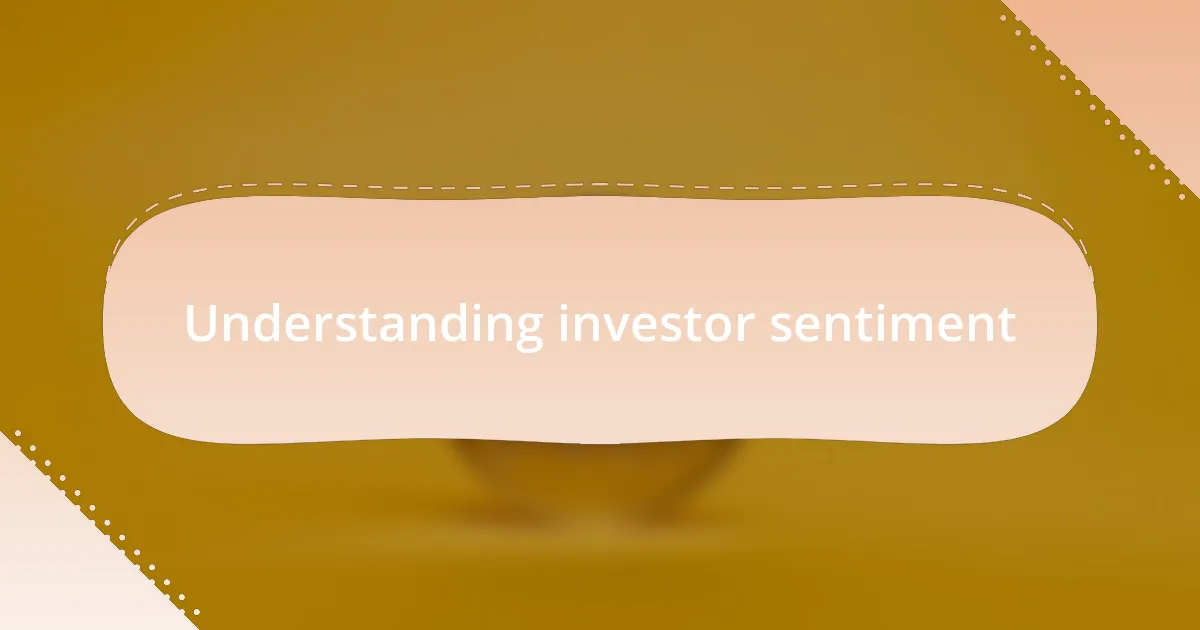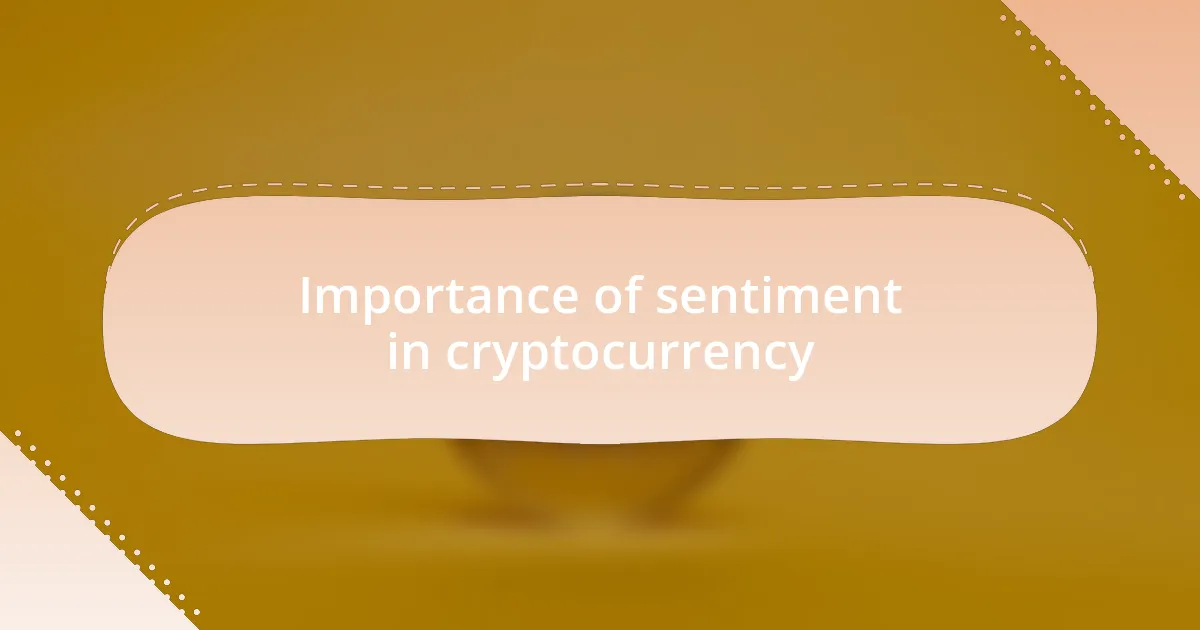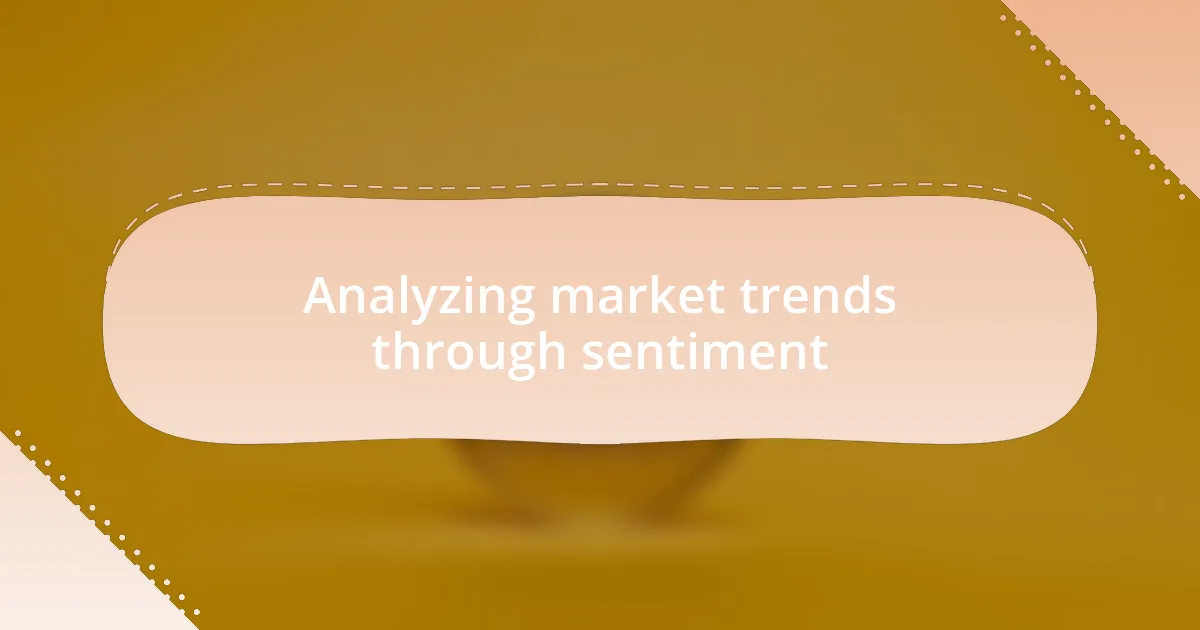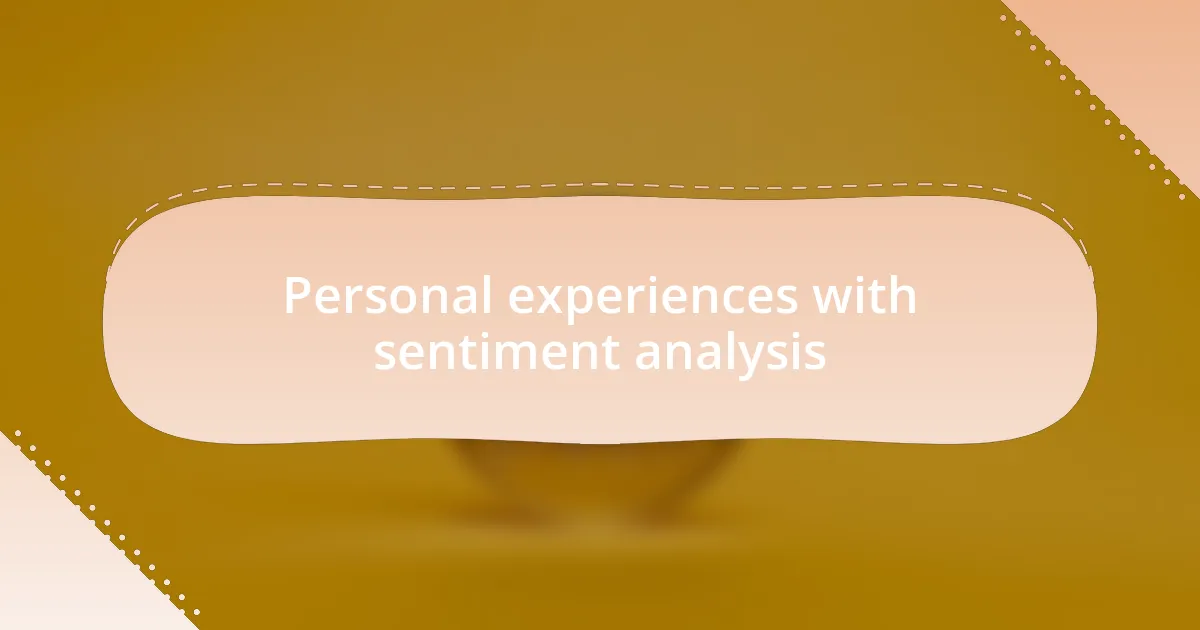Key takeaways:
- Investor sentiment significantly influences cryptocurrency price movements, often driven by emotional reactions rather than fundamental analysis.
- Monitoring social media, trading volume, and sentiment analysis tools can help gauge market sentiment and inform trading strategies.
- Tools like LunarCrush, Glassnode, and the Fear and Greed Index provide valuable insights into investor behaviors and attitudes, helping to refine trading decisions.
- Balancing fundamental analysis with sentiment analysis is essential, as emotions can impact investment choices and lead to missed opportunities.

Understanding investor sentiment
Investor sentiment represents the overall mood and attitudes of investors towards the cryptocurrency market, which can significantly impact price movements. I’ve observed how emotions can swing like a pendulum; when excitement brews around a new project, it can create a frenzy that drives prices up, while fear during market downturns can lead to panic-selling. Have you ever felt that rush when Bitcoin begins to rally? It’s truly reflective of the collective emotional state of the market.
Understanding the nuances of investor sentiment involves deciphering psychological factors that drive decision-making. I remember when news of regulatory changes emerged, and it sent ripples of uncertainty through the community. This sentiment can fuel hoarding behaviors or even lead to irrational exuberance. Have you seen those sharp, sudden price spikes that leave you questioning what just happened? Often, it’s sentiment at play, with reactions based more on anxiety or excitement than on fundamental analysis.
Furthermore, analyzing sentiment goes beyond just gauging whether people are feeling positive or negative; it’s about understanding the ‘why’ behind those feelings. I often find myself sifting through social media chatter, feeling the pulse of community sentiment. It’s fascinating how fear and greed can act as double-edged swords. So, what drives your investment decisions—data, insights, or perhaps the prevailing mood? Exploring these influences can sharpen your approach as an investor.

Importance of sentiment in cryptocurrency
Investor sentiment plays a pivotal role in shaping the cryptocurrency landscape. I’ve personally witnessed how a single tweet from a well-known figure can send a coin’s value soaring or plummeting within minutes. It really makes you think—how much do we allow external influences to dictate our investment choices? This underscores the volatility inherent in this market; emotions often overshadow facts, resulting in unpredictable price movements.
The importance of sentiment was evident to me during the infamous crypto winter. Many investors, myself included, felt a profound sense of dread as prices descended, leading some to reassess their entire strategy. I’ve learned that understanding sentiment isn’t just about tracking trends; it’s about recognizing the emotional rollercoaster that grips the community during these times. Wouldn’t it benefit us all to cultivate a more grounded approach to our investments?
When I analyze sentiment, I often connect the dots between market psychology and my own experiences. There was a phase when bullish sentiment was rampant, and FOMO (fear of missing out) took hold of my decisions. Reflecting on that, I realize how easily one can get swept up in the tide of optimism. It leaves me wondering, how can we strike a balance between our emotional reactions and sound investment practices? Recognizing the emotional drivers behind our trades can lead to more informed decisions in this ever-evolving market.

Methods for gauging investor sentiment
One effective method I use to gauge investor sentiment is by monitoring social media and online forums. Platforms like Twitter and Reddit often serve as a pulse check for community feelings. I recall a time when heightened discussions about a particular altcoin were palpable, driving its price to new heights almost overnight. It makes me wonder—how much weight should we give to the chatter versus fundamental analysis?
Another technique involves analyzing trading volume and price trends. I once noticed that a sudden spike in trading volume often accompanied a shift in sentiment, particularly during key news events. This led me to think about how collective behavior truly influences market conditions. If the trading patterns of my peers can signal a change in sentiment, shouldn’t I be more attuned to those shifts in my own trading strategies?
Lastly, sentiment analysis tools that aggregate data from various sources can provide deeper insights into market psychology. I remember experimenting with one such tool during a market downturn; it revealed that fear was overwhelming the majority of traders. This insight allowed me to adjust my approach, as I realized that fear-driven decisions often led to regrettable outcomes. Isn’t it fascinating how understanding the collective emotions of investors can shift our own strategies?
![]()
Tools for tracking sentiment metrics
When it comes to tracking sentiment metrics, one of my go-to tools has been sentiment analysis platforms like LunarCrush. I recall diving into its features during a particularly turbulent market phase; the way it aggregates social engagement data helped me visualize community interest in various coins. It’s remarkable how visualizing that data can lead to a more informed trading decision—doesn’t it feel empowering to base your strategy on actionable insights rather than just hunches?
I’ve also found value in using on-chain analytics tools, such as Glassnode, which analyze blockchain data to reveal investor behaviors. For instance, during past market rallies, observing wallet movements can indicate whether investors are holding or selling, providing critical hints about sentiment. It makes me think—how often are we considering these on-chain signals when making our trades? They can offer a more nuanced view that complements the noise found in social media.
Another resource worth exploring is the Fear and Greed Index, which distills complex market emotions into a simple number. I remember feeling a sense of urgency when the index indicated extreme fear; it encouraged me to purchase during a dip, capitalizing on opportunities that fear-based selling often creates. Isn’t it intriguing how a single metric can influence a trader’s mindset and actions in the volatile world of cryptocurrency?

Analyzing market trends through sentiment
Analyzing market trends through sentiment can provide a fascinating lens into the behaviors of investors. I recall a period when Twitter sentiment surrounding a particular altcoin surged dramatically, prompting me to reconsider my position. It was interesting to see how a wave of positive sentiment could rally a community, pushing the price higher even amid underlying fundamentals that suggested caution. This experience highlighted to me that sentiment serves as a powerful psychological force influencing market movements.
I’ve also noticed how quickly sentiment can shift, especially during significant news events or regulatory announcements. I experienced this firsthand when a sudden regulatory clampdown was announced; the fear in the community became palpable on various forums. Observing this shift in sentiment helped me make quick decisions, illustrating how real-time sentiment analysis can be the key to staying ahead—in these moments, it’s almost like having a sixth sense about the market’s next move.
Furthermore, sentiment can also be reflected in trading volume and volatility, providing essential clues. I remember analyzing a spike in buy orders coinciding with a rise in positive sentiment. That insight reinforced my belief that understanding the collective mindset of investors is crucial to navigating cryptocurrency markets effectively. Have you ever felt the thrill of making a timely trade based on sentiment shifts? It brings a unique excitement to trading that is hard to match.

Personal experiences with sentiment analysis
Reflecting on my journey with sentiment analysis, I can’t forget the time I monitored social media chatter before a major cryptocurrency conference. The buzz was palpable; people were optimistic about potential partnerships and technological advancements. This collective excitement pushed me to invest in a project that showed promise, ultimately leading to significant gains. It made me realize how sentiments can often capture the zeitgeist of the market.
There was another instance where I downplayed increasing fear in the community during a market downturn. I recall feeling a twinge of anxiety, yet I hesitated to act since the fundamental analysis seemed solid. However, sentiment swayed my sentiments to too close an extreme, and I ultimately missed the boat on an opportunity to hedge my position. This taught me a crucial lesson: balancing fundamental and sentiment analysis is essential, as emotions can cloud judgment.
One day, I stumbled upon a sentiment analysis tool that aggregated discussions from various platforms. I was intrigued and started testing it against my trades. The tool contributed to my decision-making process, especially when I saw how social media metrics correlated with price movements. It felt like unlocking a new layer of market behavior, one where emotions and trends intersected in fascinating ways. Have you ever encountered a tool that transformed your trading approach? It’s moments like these that can redefine how we interact with the market.